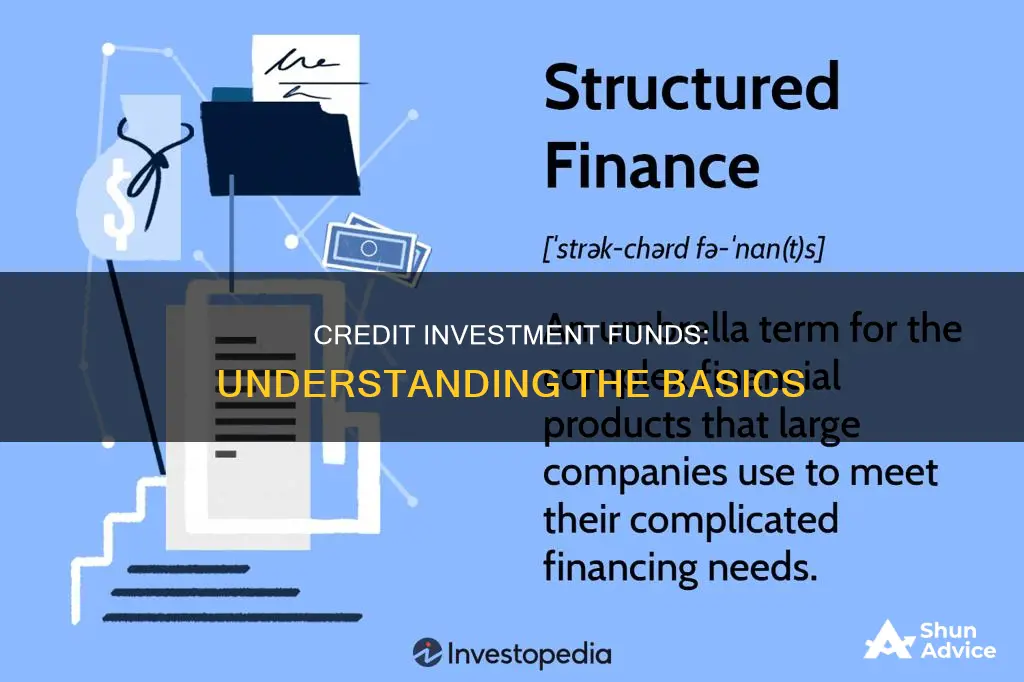
Credit investment funds are a type of closed-end private investment fund that focuses on credit investments. They are similar to traditional private equity funds but invest in various illiquid and hard-to-value credit instruments such as bonds or bank loans. The credit market refers to the marketplace through which companies and governments issue debt to investors in exchange for regular interest payments. Credit investment funds can be further categorised into direct lending, opportunistic/special situations, distressed credit, structured credit, and specialty finance. These funds are often used by investors seeking to grow their wealth while avoiding the uncertainty of equities.
Characteristics of Credit Investment Funds
| Characteristics | Values |
|---|---|
| Type of Fund | Closed-end private investment funds |
| Investment Focus | Credit investments such as various illiquid and hard-to-value credit instruments |
| Investment Strategies | Direct lending, opportunistic/special situations, distressed credit, structured credit, and specialty finance |
| Income Distribution | Funds pursuing income-producing strategies distribute current income (e.g. loan interest and fees) throughout their terms |
| Capital Gains | Funds pursuing capital gains distribute returns after capital events, through equity-like gains and recovery in debt prices |
| Similarities with Private Equity Funds | Soliciting capital commitments, initial and subsequent closings, investment and harvest periods, carried interest through a "waterfall" mechanism, and locking up limited partner capital |
| Differences from Private Equity Funds | Income distribution approaches, subsequent closing structures, recycling of capital, leverage usage, and management fee provisions |
| Risk Profile | Lower risk compared to equity funds, but susceptible to interest rate risk and default risk |
| Investor Profile | Investors seeking wealth growth, capital preservation, and low-risk income distributions |

Private credit funds
Some common types of private credit investment strategies include senior direct lending, subordinated loans, and lending to insolvent or distressed borrowers. Senior direct lending involves making senior secured loans directly to middle-market companies, while subordinated loans are a type of junior debt that combines elements of both debt and equity, with higher expected returns than traditional senior debt.
The private credit market has grown significantly in recent years, reaching $1.6 trillion across a wide range of risk and return profiles. This growth has been driven by new banking regulations that discouraged traditional corporate lending, as well as the need for capital from asset managers.
Retirement Fund: Invest Now for a Comfortable Future
You may want to see also

Direct lending
In summary, direct lending plays a crucial role in providing capital to small and medium-sized enterprises, filling a gap left by traditional banks. It offers higher yields and increased investor protections through negotiated terms, covenants, and pricing. However, it is important to note that direct lending also comes with higher risks due to the nature of the loans and the borrowers involved.
A Guide to Investing in Sustainable Funds
You may want to see also

Credit risk
The credit rating of a borrower plays a crucial role in determining the type of financing they can access and the cost of lending. Credit ratings of AAA/Aaa to BBB/Baa are deemed investment-grade, while those below BB/Ba are considered high-yield or junk bonds. High-yield bonds carry a higher risk of default but offer higher returns to compensate for the increased risk.
Interest rate risk is another factor that influences credit risk. Changes in interest rates can affect the amount of interest paid by borrowers, particularly in floating-rate loans. Floating-rate loans have limited interest rate risk as they are structured with an interest rate floor, ensuring a minimum level of income for investors. Conversely, fixed-rate loans are less affected by interest rate fluctuations, but the underlying value of the loan can be impacted if sold before maturity.
Credit investing also exposes investors to default risk, making it crucial to assess the creditworthiness of borrowers. Credit risk evaluation involves analyzing both the current financial health and future repayment prospects of borrowers. The capital stack seniority determines the order of repayment in the event of business or borrower distress, with senior debt holding the lowest risk and equity owners assuming higher risk for potentially higher returns.
In summary, credit risk in the context of credit investment funds relates to the potential for non-payment or default on interest or principal payments. This risk varies based on the credit rating of borrowers, with non-investment grade borrowers presenting a higher risk of default. Interest rate fluctuations and the possibility of default further contribute to credit risk, highlighting the importance of thorough creditworthiness assessments by investors.
Green Investment Funds: Sustainable Finance for a Greener Future
You may want to see also

Interest rate risk
Credit investment funds, also known as debt funds, are investment pools, such as mutual funds or exchange-traded funds (ETFs), that primarily invest in fixed-income securities. These funds are considered low-risk and are often sought by investors looking to preserve capital and achieve low-risk income distributions. While credit investment funds are generally less risky than equity funds, they are not without risks, including interest rate risk.
The sensitivity of a bond's price to changes in interest rates is measured by its duration, with longer-term bonds having greater price sensitivity to rate changes. Bonds with heavy interest rate risk tend to perform poorly when rates rise. For example, an investor with a five-year, $500 bond with a 3% coupon will struggle to sell the bond when newer bonds with higher interest rates enter the market. The lower demand will trigger a lower price on the secondary market, and the market value of the bond may drop below its original purchase price.
Conversely, when interest rates decrease, the value of a bond yielding a fixed return increases. This is because the bondholder receives a favourable fixed rate of return relative to the market.
A Beginner's Guide to BSE Index Fund Investing
You may want to see also

Creditworthiness
In the context of private credit funds, creditworthiness is a key consideration for investors. Private credit funds often involve privately negotiated loans between borrowers and non-bank lenders. The retrenchment of US and European banks has created opportunities for private lenders as borrowers seek flexibility, speedy execution, and surety of capital. When investing in private credit, investors should carefully assess the borrower's creditworthiness to make informed decisions and mitigate the risk of default.
Additionally, creditworthiness is an important factor in determining the capital stack seniority. Senior debt, which has the lowest risk and return potential, is typically repaid first in the event of financial trouble. Conversely, equity owners, who take on higher risk, are usually positioned below all debtholders in the capital stack and receive higher returns.
In summary, creditworthiness is a vital aspect of credit investing, particularly in the evaluation of non-investment-grade borrowers. It helps assess the borrower's financial health, prospects for repayment, and the likelihood of default. By considering creditworthiness, investors can make more informed decisions and build a well-diversified portfolio that aligns with their risk appetite and investment goals.
Mutual Funds: Smart Investment or Risky Business?
You may want to see also
Frequently asked questions
A credit investment fund is a type of investment fund that focuses on credit instruments rather than equity. These funds are typically closed-end private investment funds that invest in various illiquid and challenging-to-value credit instruments.
Common credit fund strategies include direct lending, opportunistic/special situations, distressed credit, structured credit, and specialty finance. These strategies can focus on either producing income or capital gains, resulting in varying fund terms.
Credit investment funds share structural similarities with private equity funds in terms of capital commitments, closings, investment and harvest periods, and carried interest. However, credit funds have evolved to have distinct features driven by the nature of their underlying assets.
Investing in credit markets offers a means of growing wealth while avoiding the uncertainty associated with equities. Credit markets provide regular interest payments and include a variety of investment choices, such as government-backed treasury bonds and complex illiquid structures.
Credit investment funds carry certain risks, including credit risk, interest rate risk, and default risk. Credit risk refers to the possibility of non-payment of interest or principal on a debt investment. Interest rate changes can impact the amount of interest paid by borrowers, and default risk underscores the importance of evaluating the creditworthiness of borrowers.







